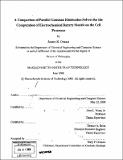A comparison of parallel Gaussian elimination solvers for the computation of electrochemical battery models on the cell processor
Author(s)
Geraci, James Russell, 1974-
DownloadFull printable version (58.89Mb)
Other Contributors
Massachusetts Institute of Technology. Dept. of Electrical Engineering and Computer Science.
Advisor
John L. Wyatt, Jr. and Thomas A. Keim.
Terms of use
Metadata
Show full item recordAbstract
The rising cost of fossil fuels, together with a push for more eco-friendly methods of transportation, has increased interest in and demand for electrically powered or assisted vehicles. The majority of these electric or hybrid electric vehicles will be, for the foreseeable future, powered by batteries. One of the major problems with batteries is their aging. For batteries, aging means that the maximum charge they can store decreases as number of charge/discharge cycles increases. Aging also means that after a certain number of charge/discharge cycles, the battery will fail. In lead-acid batteries, one of the major phenomenon that promotes battery failure is the development of a non-uniform concentration gradient of electrolyte along the electrodes' height. This phenomenon is known as electrolyte stratification. This thesis develops a simple two-level circuit model that can be used to model electrolyte stratification. The two-level circuit model is justified experimentally using digital Mach-Zehnder interferometry and is explained theoretically by means of two different electrochemical battery models. The experiments show how the usage of the electrode varies along its height while the simulations indicate that the high resistivity of the lead dioxide electrode plays a major role in the development of a stratified electrolyte. Finally, computational issues associated with the computation of a sophisticated two dimensional electrochemical battery model on the multicore Cell Broadband Engine processor are addressed in detail. In particular, three different banded parallel Gaussian elimination solvers are developed and compared. These three solvers vividly illustrate how performance achieved on the new multicore processors is strongly dependent on the algorithm used.
Description
Thesis (Ph. D.)--Massachusetts Institute of Technology, Dept. of Electrical Engineering and Computer Science, 2008. Includes bibliographical references (p. 497-505).
Date issued
2008Department
Massachusetts Institute of Technology. Department of Electrical Engineering and Computer SciencePublisher
Massachusetts Institute of Technology
Keywords
Electrical Engineering and Computer Science.